The clubmosses of Ibbenbüren
Clubmoss trees made up an important part of the swamp forests in the
Late Carboniferous. The most common genera were Lepidodendron and
Sigillaria. They differed in shape and placement of the leaf cushions,
respectively leaf scars on the trunks. The leaf cushions of
Lepidodendron are rhombic and are placed in spirals, whereas the leaf
scars of Sigillaria are more or less hexagonal and are placed in vertical
columns, separated bij ridges.
Next to these genera there are a few less common ones, such as
Lepidophloios and Asolanus. The clubmoss trees provided the
major part of the biomass, sometimes up to 75%, which later on was converted
into coal.
Note that the descriptions below are restricted to the most important
characteristics. Use guides like Josten (1991) for more certainty.
Lepidodendron
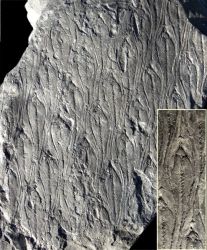 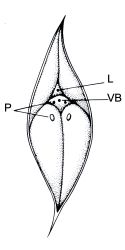 Lepidodendron aculeatum (click on the photo
on the left) has large to very large elongated rhombic leaf cushions with
long drawn out apexes. They are part of the bark of the trunk. The real leaf
scar is the little rhomb or square situated a bit above the centre. In case
of good preservation four impressions are visible on it (click on the drawing
on the right). In the middle is the scar of the vascular bundle of the leaf.
Bottom left and bottom right are scars of the parichnos tissue: a spongelike
tissue, only known from Paleozoic clubmoss trees. Probably it had a function
in the provision of air in the trunk. Below the leaf scar there are also
two parichnos scars. Above the leaf scar the cavity of the ligule is
situated, a small scalelike leaflet, sitting at the leaf, and which is
characteristic for the clubmosses. In most cases this cavity is filled up
with coaly material. Lepidodendron aculeatum (click on the photo
on the left) has large to very large elongated rhombic leaf cushions with
long drawn out apexes. They are part of the bark of the trunk. The real leaf
scar is the little rhomb or square situated a bit above the centre. In case
of good preservation four impressions are visible on it (click on the drawing
on the right). In the middle is the scar of the vascular bundle of the leaf.
Bottom left and bottom right are scars of the parichnos tissue: a spongelike
tissue, only known from Paleozoic clubmoss trees. Probably it had a function
in the provision of air in the trunk. Below the leaf scar there are also
two parichnos scars. Above the leaf scar the cavity of the ligule is
situated, a small scalelike leaflet, sitting at the leaf, and which is
characteristic for the clubmosses. In most cases this cavity is filled up
with coaly material.
As the trunk got thicker the leaf cushions grew larger. They could reach
a size of up to 10 cm. At some time, however, the bark stopped growing and
was thrown off, just like nowadays in cork oak. Many of the fossil trunk
remains of clubmoss trees are bark pieces thrown off.
|
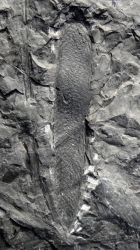 Lepidostrobus
is the spore cone of Lepidodendron. It consists of an axis with closely
placed scales, which bear the sporangia. These scales are perpendicular to
the axis, but the tip is bent upward. Lepidostrobus is only seldom
distinguishable from Sigillariostrobus. Lepidostrobus
is the spore cone of Lepidodendron. It consists of an axis with closely
placed scales, which bear the sporangia. These scales are perpendicular to
the axis, but the tip is bent upward. Lepidostrobus is only seldom
distinguishable from Sigillariostrobus.
In most cases the cones are heterosporous. The microspores are situated in
the upper part of the cone, the macrospores in the lower part. |
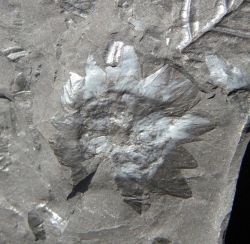 Sometimes a
'flower'-like structure is found like in the picture on the right. This is
the transverse section of a spore cone, showing the axis in the centre with
the attached cone scales. The cones, falling from a great height, got sometimes
stuck perpendicularly in the ground and were embedded in this way. This resulted
in such a transverse section. Sometimes a
'flower'-like structure is found like in the picture on the right. This is
the transverse section of a spore cone, showing the axis in the centre with
the attached cone scales. The cones, falling from a great height, got sometimes
stuck perpendicularly in the ground and were embedded in this way. This resulted
in such a transverse section. |
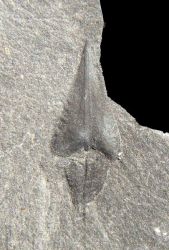 Lepidostrobophyllum
hastatum is one of the many scale-like leaflets of which the cone
consists. The sporangia were attached on the small triangular part. L.
hastatum is the short form. Lepidostrobophyllum
hastatum is one of the many scale-like leaflets of which the cone
consists. The sporangia were attached on the small triangular part. L.
hastatum is the short form. |
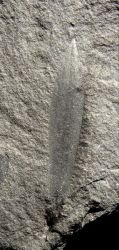 Lepidostrobophyllum
lanceolatum is a very elongated cone scale. Lepidostrobophyllum
lanceolatum is a very elongated cone scale. |
Lepidophloios
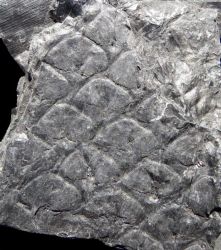 Lepidophloios laricinus has leaf cushions, which are, contrarily
to those of Lepidodendron, wider than high. In case of good conservation
a leaf scar is visible in the lower part of the leaf cushion.
Lepidophloios laricinus has leaf cushions, which are, contrarily
to those of Lepidodendron, wider than high. In case of good conservation
a leaf scar is visible in the lower part of the leaf cushion.
Trees of the genus Lepidophloios resembled those of
Lepidodendron but they were less high. The spore cones are hardly
distinguishable from those of Lepidodendron and therefore are usually
also called Lepidostrobus. |
Sigillaria of zegelboom
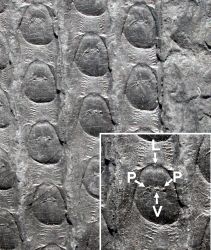 Sigillaria
trees grew less high than trees of Lepidodendron but they could still
reach a size of up to 20 m. Whereas the leaf scars of Lepidodendron are
small and placed on a leaf cushion, in Sigillaria they are larger
and covering the leaf cushion. Sigillaria
trees grew less high than trees of Lepidodendron but they could still
reach a size of up to 20 m. Whereas the leaf scars of Lepidodendron are
small and placed on a leaf cushion, in Sigillaria they are larger
and covering the leaf cushion.
Just as in Lepidodendron the scars of the parichnos, the vascular
bundle and the ligule are visible in case of good preservation (photo on
the left).
The leaf scars are positioned in vertical rows, mostly separated by ribs.
|

Sketch of the characteristics of the species described below (after Josten,
1991) |
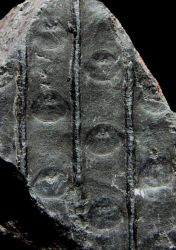 Sigillaria
ovata has rounded to elongated oval leaf scars, standing rather distant
from each other. Sigillaria
ovata has rounded to elongated oval leaf scars, standing rather distant
from each other.
No wrinkles and no descending lines. |
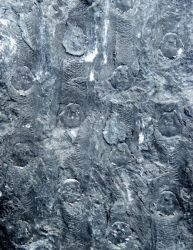 Sigillaria
scutellata has (often) somewhat clock-shaped leaf scars
with small descending lines from the lateral angles. Below the scars is a
clear wrinkling. The distance of the scars is 1 to 3 scar lengths. Sigillaria
scutellata has (often) somewhat clock-shaped leaf scars
with small descending lines from the lateral angles. Below the scars is a
clear wrinkling. The distance of the scars is 1 to 3 scar lengths. |
 Sigillaria
laevigata has leaf scars with pointed lateral angles from which lines
are descending. The scars are rather remote from each other. No wrinkles. Sigillaria
laevigata has leaf scars with pointed lateral angles from which lines
are descending. The scars are rather remote from each other. No wrinkles.
|
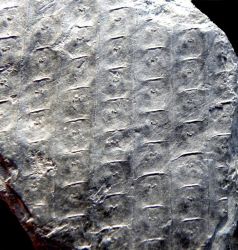 Sigillaria
tesselata has hexagonally rounded leaf scars, which are very closely
placed. There is a transverse line on top of the scars, but no further
wrinkles. Sigillaria
tesselata has hexagonally rounded leaf scars, which are very closely
placed. There is a transverse line on top of the scars, but no further
wrinkles. |
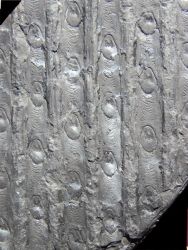 Sigillaria
rugosa has elongated, pear-shaped or drop-shaped leaf scars, standing
at a considerable distance of each other. There is an irregular wrinkling
between the scars. Sigillaria
rugosa has elongated, pear-shaped or drop-shaped leaf scars, standing
at a considerable distance of each other. There is an irregular wrinkling
between the scars. |
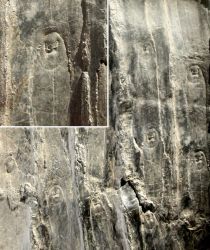 Sigillaria
principis has broader than wide, elliptic to rounded leaf
scars, standing at a considerable distance of each other. There are descending
lines from the lateral corners and above the scar is a arched line. No wrinkles
are present. Sigillaria
principis has broader than wide, elliptic to rounded leaf
scars, standing at a considerable distance of each other. There are descending
lines from the lateral corners and above the scar is a arched line. No wrinkles
are present. |
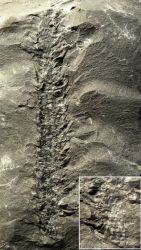 Sigillariostrobus
is the spore cone of the Sigillaria tree. In immature cones the many
scales are packed on the axis so that only the upward bent tips of the scales
can be seen. Such cones cannot be distinguished from those of
Lepidodendron. As soon as the cone was mature the scales fell off
and in this case the point-shaped scars at the axis are arranged in a low
upward spiral. In Lepidostrobus the spiral is much more clear and
steep. Complete cones of Sigillariostrobus are very rare. Sigillariostrobus
is the spore cone of the Sigillaria tree. In immature cones the many
scales are packed on the axis so that only the upward bent tips of the scales
can be seen. Such cones cannot be distinguished from those of
Lepidodendron. As soon as the cone was mature the scales fell off
and in this case the point-shaped scars at the axis are arranged in a low
upward spiral. In Lepidostrobus the spiral is much more clear and
steep. Complete cones of Sigillariostrobus are very rare. |
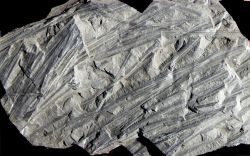 Sigillariophyllum
is the leaf of Sigillaria. It is very long and has a ridge on the
lower side. The leaves are nearly always found detached. Sigillariophyllum
is the leaf of Sigillaria. It is very long and has a ridge on the
lower side. The leaves are nearly always found detached. |
Syringodendron
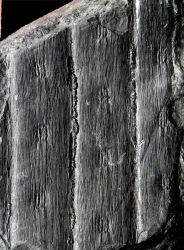 Syringodendron
is the trunk of Sigillaria from which the bark has fallen off. Syringodendron
is the trunk of Sigillaria from which the bark has fallen off.
The ribs are still visible as are the pairs of parichnos scars ('hare's
trails'). |
Stigmaria
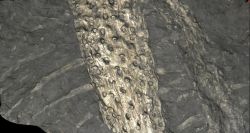 Stigmaria
is the name of the root bearers of Lepidodendron- as well as of
Sigillaria trees. They were growing widely and superficially,
forking dichotomously and could in this manner take up a large surface. This
adaptation made it possible for the trees to stay upright in a swampy
environment. When the rootlets had disappeared, circular scars (stigmata)
remained. Stigmaria
is the name of the root bearers of Lepidodendron- as well as of
Sigillaria trees. They were growing widely and superficially,
forking dichotomously and could in this manner take up a large surface. This
adaptation made it possible for the trees to stay upright in a swampy
environment. When the rootlets had disappeared, circular scars (stigmata)
remained. |
Asolanus
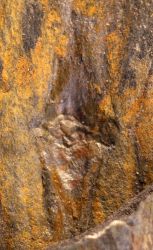 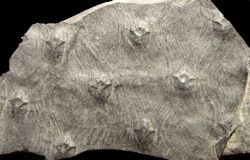 Asolanus camptotaenia is the only species of the genus. It is
a tree of which the leaflets resemble those of Lepidodendon. The leaf
scars are rhombic and they are arranged in wide spirals. The scars are always
wider than high. Characteristic is the striation which is swinging in between
the scars (photo on the left).
Asolanus camptotaenia is the only species of the genus. It is
a tree of which the leaflets resemble those of Lepidodendon. The leaf
scars are rhombic and they are arranged in wide spirals. The scars are always
wider than high. Characteristic is the striation which is swinging in between
the scars (photo on the left).
Sometimes above and below the scars triangular expansions can be seen, resembling
leaf cushions (click on the photo on the right). |
Bothrodendron
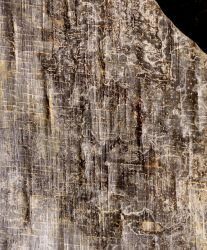 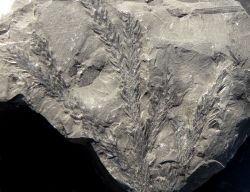 Bothrodendron
minutifolium is a big tree, resembling Lepidodendron, but with
much smaller leaflets. At the twigs a very fine wrinkling is visible, running
transversely to the longitudinal direction of the axis. The leaf scars are
also very small. Bothrodendron
minutifolium is a big tree, resembling Lepidodendron, but with
much smaller leaflets. At the twigs a very fine wrinkling is visible, running
transversely to the longitudinal direction of the axis. The leaf scars are
also very small.
At the trunk large scars of fallen off branches can be found.
Knorria (trunk without bark) is characterized bij furrowlike holes in the
longitidinal direction (photo on the right). |
Top |